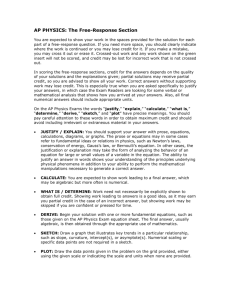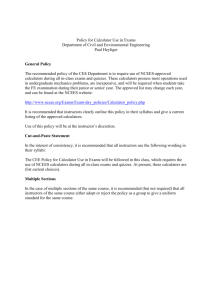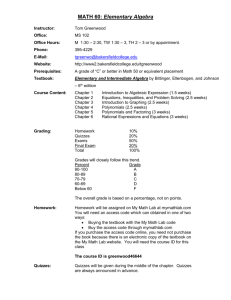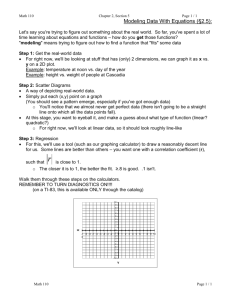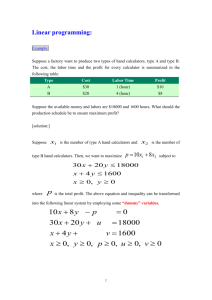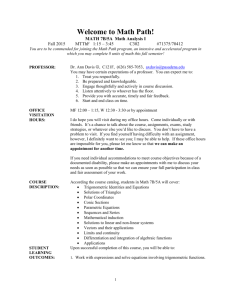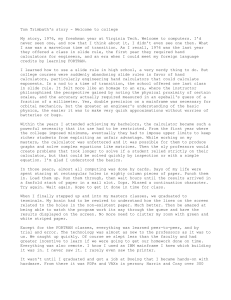Things to know for AP Exam
advertisement
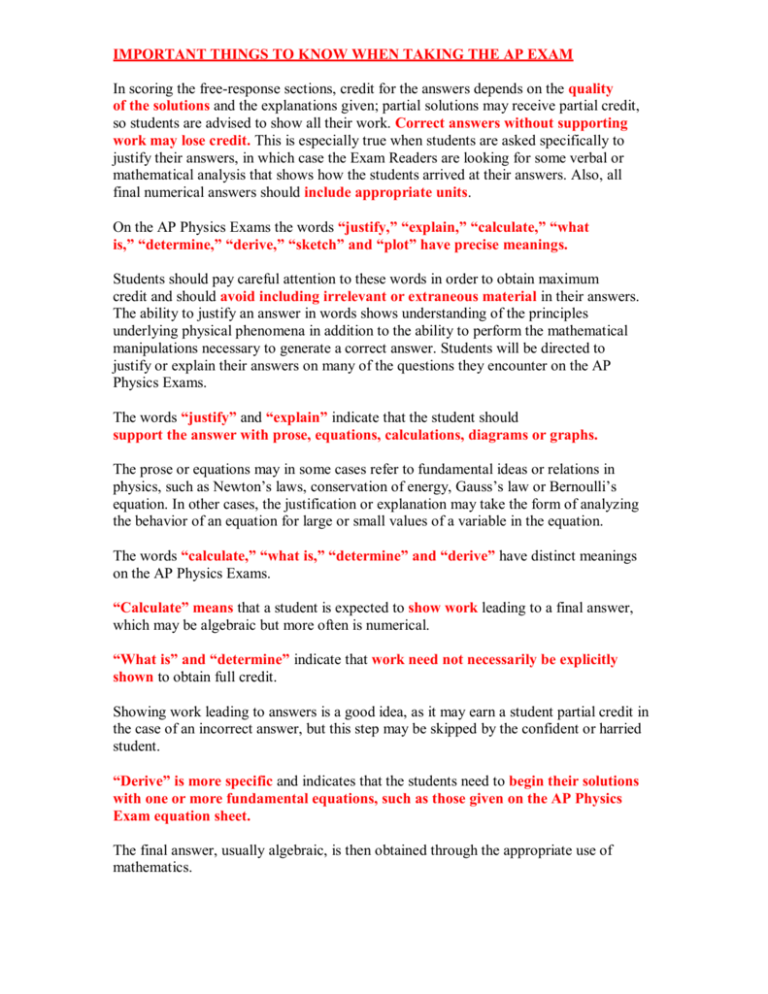
IMPORTANT THINGS TO KNOW WHEN TAKING THE AP EXAM In scoring the free-response sections, credit for the answers depends on the quality of the solutions and the explanations given; partial solutions may receive partial credit, so students are advised to show all their work. Correct answers without supporting work may lose credit. This is especially true when students are asked specifically to justify their answers, in which case the Exam Readers are looking for some verbal or mathematical analysis that shows how the students arrived at their answers. Also, all final numerical answers should include appropriate units. On the AP Physics Exams the words “justify,” “explain,” “calculate,” “what is,” “determine,” “derive,” “sketch” and “plot” have precise meanings. Students should pay careful attention to these words in order to obtain maximum credit and should avoid including irrelevant or extraneous material in their answers. The ability to justify an answer in words shows understanding of the principles underlying physical phenomena in addition to the ability to perform the mathematical manipulations necessary to generate a correct answer. Students will be directed to justify or explain their answers on many of the questions they encounter on the AP Physics Exams. The words “justify” and “explain” indicate that the student should support the answer with prose, equations, calculations, diagrams or graphs. The prose or equations may in some cases refer to fundamental ideas or relations in physics, such as Newton’s laws, conservation of energy, Gauss’s law or Bernoulli’s equation. In other cases, the justification or explanation may take the form of analyzing the behavior of an equation for large or small values of a variable in the equation. The words “calculate,” “what is,” “determine” and “derive” have distinct meanings on the AP Physics Exams. “Calculate” means that a student is expected to show work leading to a final answer, which may be algebraic but more often is numerical. “What is” and “determine” indicate that work need not necessarily be explicitly shown to obtain full credit. Showing work leading to answers is a good idea, as it may earn a student partial credit in the case of an incorrect answer, but this step may be skipped by the confident or harried student. “Derive” is more specific and indicates that the students need to begin their solutions with one or more fundamental equations, such as those given on the AP Physics Exam equation sheet. The final answer, usually algebraic, is then obtained through the appropriate use of mathematics. The words “sketch” and “plot” relate to student-produced graphs. “Sketch” means to draw a graph that illustrates key trends in a particular relationship, such as slope, curvature, intercept(s), or asymptote(s). Numerical scaling or specific data points are not required in a sketch. “Plot” means to draw the data points given in the problem on the grid provided, either using the given scale or indicating the scale and units when none are provided. Exam questions that require the drawing of free-body or force diagrams will direct the students to “draw and label the forces (not components) that act on the [object]”, where [object] is replaced by a reference specific to the question, such as “the car when it reaches the top of the hill.” Any components that are included in the diagram will be scored in the same way as incorrect or extraneous forces. In addition, in any subsequent part asking for a solution that would typically make use of the diagram, the following will be included: “If you need to draw anything other than what you have shown in part [x] to assist in your solution, use the space below. Do NOT add anything to the figure in part [x].” This will give students the opportunity to construct a working diagram showing any components that are appropriate to the solution of the problem. This second diagram will not be scored. Strict rules regarding significant digits are usually not applied to the scoring of numerical answers. However, in some cases answers containing too many digits may be penalized. In general, two to four significant digits are acceptable. Exceptions to these guidelines usually occur when rounding makes a difference in obtaining a reasonable answer. For example, suppose a solution requires subtracting two numbers that should have five significant digits and that differ starting with the fourth digit (e.g., 20.295 and 20.278). Rounding to three digits will lose the accuracy required to determine the difference in the numbers, and some credit may be lost. Simplification of algebraic and numerical answers is encouraged, though it should always be balanced with students’ efficient use of exam time. Simplifying an answer will often reveal a characteristic of the underlying physics that may be useful in a subsequent part of the exam question. A simplified answer is the clearest way to communicate with the professors and AP teachers who score the exams. Equivalent answers are entitled to full credit, and the Exam Readers always evaluate unsimplified answers for correctness. Yet, however careful the Readers are, there is always the chance for error in their evaluations, and thus simplification may be in the students’ best interest. Additional information about study skills and test-taking strategies can be found at AP Central. Calculators and Equation Tables Policies regarding the use of calculators on the exams take into account the expansion of the capabilities of scientific calculators, which now include not only programming and graphing functions but also the availability of stored equations and other data. For taking the sections of the exams in which calculators are permitted, students should be allowed to use the calculators to which they are accustomed, except as noted below.* On the other hand, they should not have access to information in their calculators that is not available to other students, if that information is needed to answer the questions. Calculators are not permitted on the multiple-choice sections of the Physics B and Physics C exams. The purpose of the multiple-choice sections is to assess the breadth of students’ knowledge and understanding of the basic concepts of physics. The multiple-choice questions emphasize conceptual understanding and qualitative applications. However, many physical definitions and principles are quantitative by nature and can therefore be expressed as equations. The knowledge of these basic definitions and principles, expressed as equations, is a part of the content of physics that should be learned by physics students and will continue to be assessed in *Exceptions to calculator use. Calculators that are not permitted are: PowerBooks and portable/handheld computers electronic writing pads or pen-input/stylus-driven devices (e.g., Palm, PDAs, Casio ClassPad 300) pocket organizers models with QWERTY (i.e., typewriter) keypads (e.g., TI-92 Plus, Voyage 200) models with paper tapes models that make noise or “talk” models that require an electrical outlet cell phone calculators Students may not share calculators.
